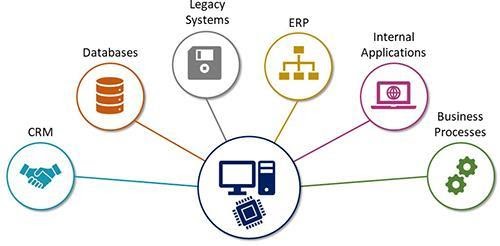What is integration in IT?
Most of us probably heard about this term, but what does it actually mean?
At the simplest level, integration is the process of combining two or more units to create a whole. In business terms, integration often refers to software or system integration, which means joining multiple systems to cooperate as one. So basically, integration allows information to be shared between the connected systems.
The final result of integration is having a different subsystems working together so that the data contained in each becomes part of a larger, more comprehensive system that, ideally, quickly and easily shares data when needed. This often requires that companies build a customized architecture or structure of applications to combine new or existing hardware, software, and other communications. These integration solutions can come in many forms, regardless of industry, as long as multiple systems, applications, devices, or datasets need to be connected.

What are the benefits?
Some of the main advantages of integrating systems are:
- Reducing costs
- Optimization of business processes
- Access to real-time data
- Usage of new data in new ways
- Improved scalability and more
Financial savings are, without question, among the most attractive benefits of system integration. Reducing overhead costs and other expenses by consolidating systems into a single platform, when possible, and connecting platforms that will remain in place is a result of a custom-built system integration strategy. The process of upgrading technology is inevitable – old software may not process data in the same manner as the new, a new service may need to be connected and the old system may not be able to support the functionality at all. However, replacement with a better system is a costly move. The integration allows cost-saving, by providing a central pipeline through which both old and new systems can communicate, using the existing infrastructure and gradually adding new functionalities and growing incrementally as needed.
Optimization of processes efficiency and streamlined operations are major benefits that come along, followed by greater business agility and smarter business decisions, as with integration, evaluations are based upon accurate, real-time data.
A fully-integrated system will open the door to new data collection opportunities. More data means more metrics and more insights, which allows improvements, enhancements, and other positive changes. Most modern system integration strategies demand the usage of cloud-based storage, cloud computing, and other cloud resources. Scalability is an important part of the equation, both from a financial standpoint and from a strategic perspective.
It’s also important that customers can access and request the information they need at any time. If they do not have a fast, positive experience with a website or integrated service offered by a business, it is unlikely they will be returning customers.

The final result of integration is having a different subsystems working together so that the data contained in each becomes part of a larger, more comprehensive system that, ideally, quickly and easily shares data when needed.
Real-life examples
CRM
One of the most common real-life examples is CRM (customer relationship management). Companies strive to integrate their CRM systems with other components of the business to help streamline the marketing and sales processes, organizing and updating customer information, expanding customer relationships and boosting revenue and growth. The main goal of integrating a CRM system with other, smaller systems is to prevent manual data entry and save employees time by removing redundant or unnecessary everyday tasks. For example, a company might integrate its website with its marketing automation software to bring customer information directly into the CRM system. Any action a potential client takes on the website can be logged and a new record can be automatically created in the system. The world’s number one CRM is Salesforce, a cloud-based, multi-solution platform that hosts applications that customers can access online. Whether there is a need to promote a service, sell a product, or organize a community, Salesforce helps keep track of all customer and client information and interactions, ensuring that nothing is missed or overseen.
Finance

Fraud is a huge and growing problem in finance. Banks, mobile network providers, and other companies can identify, eliminate, and prevent fraud if all their data is integrated. If so, the data anomalies and outliers can be searched for and fraudsters can often be caught before they affect both the companies and customers. However, if the data is fragmented, that kind of early intervention is not possible. Another important aspect is significant growth in customer demands for digital services. One example is how HSBC, one of the world’s largest banking and financial services institutions, solved this issue. They have turned to the cloud to reduce operational costs and increase innovation. MuleSoft built thousands of APIs deployed across multiple environments to unlock access to on-premises systems and power cloud-native application development.
Telecommunications
Integrating data from as many sources as possible provides a greater quality of customer service, which is a major concern in telecommunications. Issues that lead to more customer complaints or poor customer service encounters can be identified and corrected. Eventually, with enough data, companies can treat every customer as an individual. One of the great examples is Tibco. Specifically, for the telecom and media market, TIBCO’s model-driven process orchestration allows telecom carriers and media distributors to digitally transform both the Business Support System (BSS) and the Operations Support System (OSS).
Marketing

As integration gives us well-organized, accurate, and up-to-date data, naturally, it found its practical application in marketing. Integrated marketing campaigns consist of usage of different communication channels for the placement of unified communication message to chosen target. That message is specially created for every communications channel, created in special type or format. The idea is to get to the target group on different places. The most often is used the combination of digital marketing, television and “outdoor” promotion.
The great example of an integrated marketing campaign is Coke’s “Share a Coke with” campaign, which used unified messaging across TV, social networks, and outdoor, leading to a 7% uplift in Coke consumption by the target demographic, making it one of the most successful Coke campaigns in history.
Healthcare
Treating a patient requires as much information as possible. When that data is spread across systems, it only compromises care. Integrating as much patient data as possible into one comprehensive unit is necessary for every instance of the healthcare industry. Controlling costs, improving health and outcomes are all possible once the health data becomes more comprehensive. One of the great examples is MuleSoft Accelerator for Healthcare.
This solution offers the ability to unlock patient’s data to build a patient’s 360 overview within Salesforce Health Cloud, faster and easier than ever before. The solution includes pre-built APIs, connectors, integration templates, and prescriptive end-to-end reference architecture to bring patient’s demographics information and COVID-19 test results from any EHR (Electronic Health Record) into Health Cloud using HL7 V2 or FHIR standards.

Tools supporting everyday work
Many tools that we use, such as email or Google docs, have built-in integrations to allow the work automation and eliminate the unnecessary amount of repetitive steps. One of them is for example Zapier. This tool links the apps so that they share data. It can be used for Slack, Dropbox, Asana, Gmail, and more. While the application data seems unrelated, Zapier helps in creating chains of connections, making the company’s day-to-day tasks much easier.
Ecommerce
To minimize human involvement and save businesses time and money, e-commerce uses integrations and it is quite dependent on them. Some of the major E-commerce integration applications are:
- Payment Gateways Integrations
- Shipping Software
- Customer Support Software
- Social Media E-Commerce Integrations and more
Payment Gateways Integrations

To connect to a payment gateway, customers can choose between 2 types of payment gateway integration – redirect integrations and on-site payment gateways (direct payment gateways). The most familiar examples are:
- Paypal – offers online checkout experiences, invoicing, and in-person payments
- Stripe – online payment API which is the best fit for high-tech B2C e-commerce businesses
- Square – provides POS systems, online checkout experiences, and invoicing
Shipping Software
When a product is purchased online, that order needs to be processed, picked, packed and shipped before arriving at the customer’s door. E-commerce shipping integrations streamline this process thanks to connectivity and automation while ensuring accuracy and transparency to keep customers satisfied.
Top E-commerce shipping software solutions: Shippo, ShippingEasy, Ordoro, OrderCup, etc.
Customer Support Software
According to different e-commerce studies, the average shopping cart abandonment rate is as high as 68.81%. Emails that will alert about these events are certainly one way to catch these nearly lost sales, capturing customers while they are still on the site is worth considering, so their concerns about the products, the checkout process, or return policy can be mitigated.
Top live chat software for E-commerce: LiveChat, Tidio, ProProfs, Olark, etc.
Social Media E-Commerce Integrations
The most common features of E-commerce sites today include social media integrations, which benefit businesses in the following ways.
- Bring more traffic to a site
- Increase engagement for social profiles of a brand
- Amplify business reach
- Provide customers with additional, more friendly channels to communicate with a brand

Customers can share the products of a site on social media and they can also subscribe to an email list by using some of these channels.
Conclusion
Integration efforts are based largely on customer data. Various integration solutions offer us customer data platforms that unify all the data and manage that data in the best possible way.
Many people think that increasing the technology used in business integration will lead to less need for human interference. However, if we really think about it, that only means more time that can be spent on non-tech activities, like face-to-face customer interaction and it clears up time for more meaningful work.

